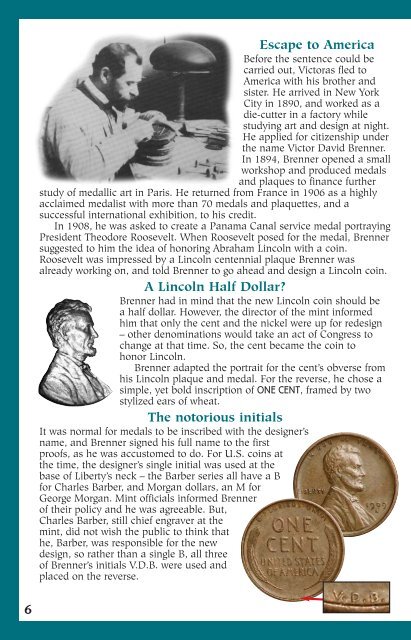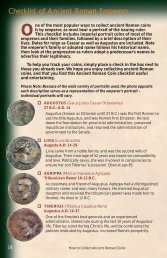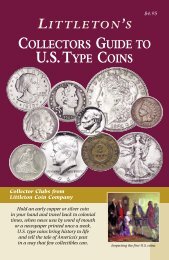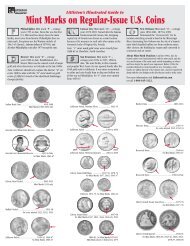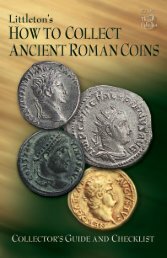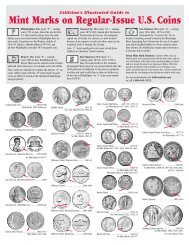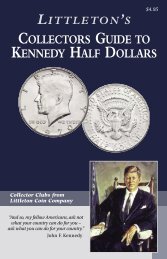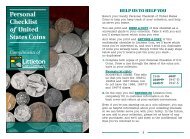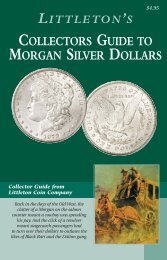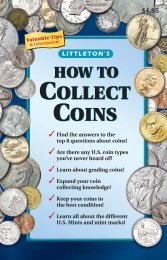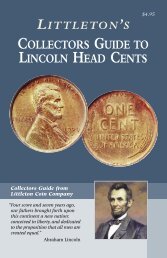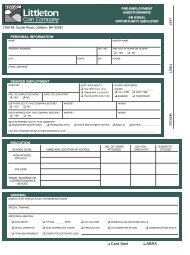Collectors Guide to Lincoln Head Cents - Littleton Coin Company
Collectors Guide to Lincoln Head Cents - Littleton Coin Company
Collectors Guide to Lincoln Head Cents - Littleton Coin Company
Create successful ePaper yourself
Turn your PDF publications into a flip-book with our unique Google optimized e-Paper software.
6Escape <strong>to</strong> AmericaBefore the sentence could becarried out, Vic<strong>to</strong>ras fled <strong>to</strong>America with his brother andsister. He arrived in New YorkCity in 1890, and worked as adie-cutter in a fac<strong>to</strong>ry whilestudying art and design at night.He applied for citizenship underthe name Vic<strong>to</strong>r David Brenner.In 1894, Brenner opened a smallworkshop and produced medalsand plaques <strong>to</strong> finance furtherstudy of medallic art in Paris. He returned from France in 1906 as a highlyacclaimed medalist with more than 70 medals and plaquettes, and asuccessful international exhibition, <strong>to</strong> his credit.In 1908, he was asked <strong>to</strong> create a Panama Canal service medal portrayingPresident Theodore Roosevelt. When Roosevelt posed for the medal, Brennersuggested <strong>to</strong> him the idea of honoring Abraham <strong>Lincoln</strong> with a coin.Roosevelt was impressed by a <strong>Lincoln</strong> centennial plaque Brenner wasalready working on, and <strong>to</strong>ld Brenner <strong>to</strong> go ahead and design a <strong>Lincoln</strong> coin.A <strong>Lincoln</strong> Half Dollar?Brenner had in mind that the new <strong>Lincoln</strong> coin should bea half dollar. However, the direc<strong>to</strong>r of the mint informedhim that only the cent and the nickel were up for redesign– other denominations would take an act of Congress <strong>to</strong>change at that time. So, the cent became the coin <strong>to</strong>honor <strong>Lincoln</strong>.Brenner adapted the portrait for the cent’s obverse fromhis <strong>Lincoln</strong> plaque and medal. For the reverse, he chose asimple, yet bold inscription of ONE CENT, framed by twostylized ears of wheat.The no<strong>to</strong>rious initialsIt was normal for medals <strong>to</strong> be inscribed with the designer’sname, and Brenner signed his full name <strong>to</strong> the firstproofs, as he was accus<strong>to</strong>med <strong>to</strong> do. For U.S. coins atthe time, the designer’s single initial was used at thebase of Liberty’s neck – the Barber series all have a Bfor Charles Barber, and Morgan dollars, an M forGeorge Morgan. Mint officials informed Brennerof their policy and he was agreeable. But,Charles Barber, still chief engraver at themint, did not wish the public <strong>to</strong> think thathe, Barber, was responsible for the newdesign, so rather than a single B, all threeof Brenner’s initials V.D.B. were used andplaced on the reverse.


